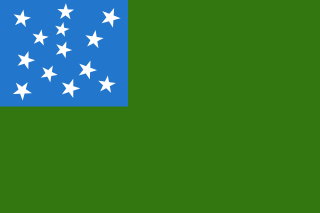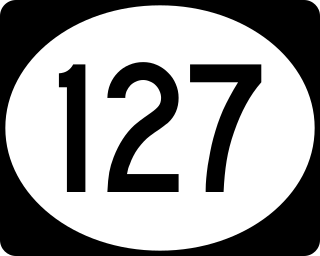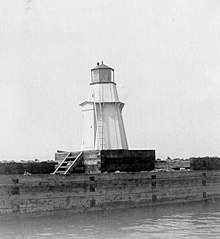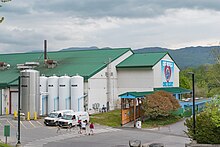
The Green Mountain Boys were a militia organization established in 1770 in the territory between the British provinces of New York and New Hampshire, known as the New Hampshire Grants and later in 1777 as the Vermont Republic. Headed by Ethan Allen and members of his extended family, it was instrumental in resisting New York's attempts to control the territory, over which it had won de jure control in a territorial dispute with New Hampshire.

Montpelier is the state capital of the U.S. state of Vermont and the county seat of Washington County. The site of Vermont's state government, it is the least populous state capital in the United States. As of the 2020 census, the population was 8,074, with a daytime population growth of about 21,000 due to the large number of jobs within city limits. The Vermont College of Fine Arts is located in the municipality. It was named after Montpellier, a city in the south of France.

Burlington, officially the City of Burlington, is the most populous city in the U.S. state of Vermont and the seat of Chittenden County. It is located 45 miles (72 km) south of the Canada–United States border and 95 miles (153 km) south of Montreal. As of the 2020 U.S. census, the population was 44,743. It is the least populous city in the 50 U.S. states to be the most populous city in its state.

Chittenden County is the most populous county in the U.S. state of Vermont. As of the 2020 census, its population was 168,323. The county seat is Vermont's most populous municipality, the city of Burlington. The county has over a quarter of Vermont's population and more than twice the population of Vermont's second-most populous county, Rutland. The county also has more than twice the population density of Vermont's second-most dense county, Washington. The county is named for Vermont's first governor and one of the framers of its constitution as an independent republic and later U.S. state, Thomas Chittenden.

Vergennes is a city located in the northwest quadrant of Addison County, Vermont, United States. The municipality is bordered by the towns of Ferrisburgh, Panton, and Waltham. As of the 2020 census, its population was 2,553. It is the smallest of Vermont's 10 cities in terms of population, though the city of Winooski has the smallest area. It was the first city chartered in the state of Vermont and is the only city in Addison County.

Colchester is a town in Chittenden County, Vermont, United States. As of the 2020 census, the population of Colchester was 17,524. It is the third-most populous municipality and most populous town in the state of Vermont. Colchester borders Burlington, Vermont's most populous municipality and is part of its metropolitan area. The town is directly to Burlington's north on the eastern shore of Lake Champlain, to the west of the Green Mountains. The Vermont National Guard is based in the town, and it is also home to Saint Michael's College and the Vermont campus of Southern New Hampshire University.

Essex Junction is a city in Chittenden County, Vermont, United States. As of the 2020 U.S. census, the population was 10,590. It was incorporated as a village on November 15, 1892. Essex Junction became Vermont’s 10th city on July 1, 2022.

Shelburne is a town in Chittenden County, Vermont, United States. Located along the shores of Lake Champlain, Shelburne's town center lies approximately 7 miles (11 km) south of the city center of Burlington, the most populous city in the U.S. state of Vermont. As of the 2020 census, the population of Shelburne was 7,717.

South Burlington is a city in Chittenden County, Vermont, United States. Along with neighboring Burlington, it is a principal city of the Burlington metropolitan area. As of the 2020 U.S. census, the population was 20,292, making it the second-most populous city in Vermont after Burlington. It is home to the headquarters of Ben & Jerry's and the state of Vermont's largest mall, the University Mall.

Williston is a town in Chittenden County, Vermont, United States. Originally rural and laid out with many farms, in recent decades it has developed into a thriving suburb of Burlington, the largest city in the state of Vermont. As of the 2020 census, the population of Williston was 10,103, an increase of over 1,000 people since the 2010 census. Williston is one of the fastest-growing towns in Vermont, and while becoming more populated, it has also developed as a major retail center for the Burlington area as well as much of central and northern Vermont. The town has a National Register Historic District in its unincorporated central village.

Winooski is a city in Chittenden County, Vermont, United States. Located on the Winooski River, as of the 2020 U.S. census the municipal population was 7,997. The city is the most densely populated municipality in northern New England, an area comprising the states of Maine, New Hampshire, and Vermont. It is the smallest of Vermont's 10 cities by area, though the city of Vergennes has the smallest population. As part of the Burlington, Vermont metropolitan area, it is bordered by Burlington, Colchester, and South Burlington.

The Winooski River is a tributary of Lake Champlain, approximately 90 miles (145 km) long, in the northern half of Vermont. Although not Vermont's longest river, it is one of the state's most significant, forming a major valley way from Lake Champlain through the Green Mountains towards the Connecticut River valley.

U.S. Route 2 (US 2) is a part of the United States Numbered Highway System that is split into two segments. Its eastern segment runs from Rouses Point, New York, to Houlton, Maine. In Vermont, US 2 extends 150.518 miles (242.235 km) from the New York state line in Alburgh to the New Hampshire state line in Guildhall. West of Vermont, US 2 continues into New York for another 0.87 miles (1.40 km) to an intersection with US 11 in Rouses Point. US 2 passes through the cities of Burlington and Montpelier as it traverses the state. The highway parallels Interstate 89 (I-89) between these two cities. The Burlington to Montpelier route was first laid out as a toll road in the early 19th century. It was later incorporated into the transcontinental auto trail known as the Theodore Roosevelt International Highway in 1919 before being designated as part of US 2 in 1926.

Vermont Route 127 (VT 127) is a state highway in Chittenden County, Vermont, United States. It currently exists in two segments: a signed, locally maintained portion in the city of Burlington and the town of Colchester, and an unsigned, state-maintained portion within the town of Colchester. The southern terminus of the signed segment is at Pearl Street in downtown Burlington. Its northern terminus is at U.S. Route 2 and U.S. Route 7 in Colchester. The unsigned segment is little more than the southern leg of a wye connection between US 2 / US 7 and VT 2A.

The Burlington metropolitan area is a metropolitan area consisting of the three Vermont counties of Chittenden, Franklin, and Grand Isle. The metro area is anchored by the principal cities of Burlington, South Burlington, St. Albans, Winooski, and Essex Junction; and the towns of Colchester, Essex and Milton. According to the 2020 U.S. Census, the metro area had a population of 225,562, approximately one third of Vermont's total population; in 2023, the estimated population was 227,942.

Levi Underwood was a lawyer and politician from Vermont. Originally a Democrat, Underwood's antislavery views caused him to join the new Republican Party when it was founded. Underwood was most notable for his service as the 23rd lieutenant governor of Vermont from 1860 to 1862.

The Winooski Falls Mill District is located along the Winooski River in the cities of Winooski and Burlington, Vermont, in the United States of America. It encompasses a major industrial area that developed around two sets of falls on the river in the 19th century.
William Weston was an attorney and politician in Burlington, Vermont, and Brooklyn, New York. He served in several local and state offices, and is most notable for his service as a member of the Vermont Senate in the 1850s.

William A. Crombie was a businessman and local government official in Burlington, Vermont. A Republican, among the offices in which he served was mayor of Burlington (1889-1891).

Daniel Roberts was an American attorney and politician from Vermont. Involved in the Abolitionist movement as well as reform causes including Temperance, he was active in the Liberty, Free Soil, and Democratic parties before becoming identified with the Republican Party when it was founded in the mid-1850s as America's main antislavery party.

























